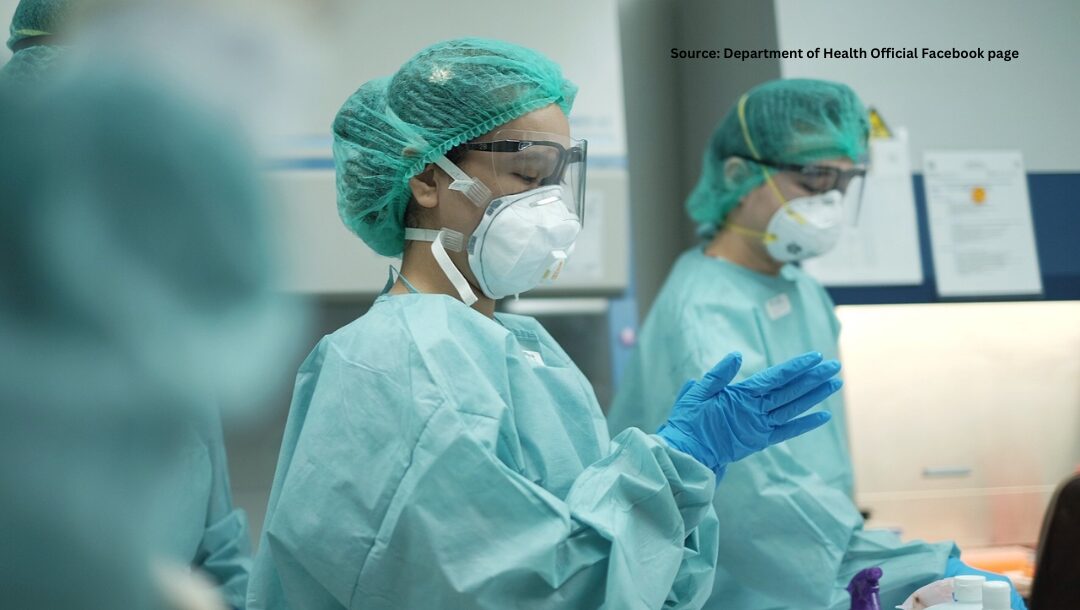A recent Universal Health Care (UHC) survey revealed that a substantial number of Filipino healthcare workers (HCWs) are considering leaving their medical facilities within the next year.
Of the nearly 11,000 active HCWs who responded, 48.3% said they were thinking of quitting their medical jobs, according to data analytics group IDinsight. Most of those who expressed their desire to leave are physicians, nurses and midwives.
The results were presented by Dr. Alice Redfern, associate director at IDinsight, in her executive summary at the 20th National Health Research Forum for Action 2024, organized by the Department of Health (DOH) last October 24.
“This has been a common topic of discussion this year among the DOH… It’s a considerable number that do have plans to leave,” she lamented.
These workers primarily work in government facilities like rural health units and public hospitals, while a select few are from “private facilities who had a strong partnership with DOH,” IDinsight stated in an email.
The UHC survey revealed most healthcare workers with definitive plans to quit are thinking of migrating to another country and exiting the national health system altogether.

Burnout is the culprit
The survey looked into the factors behind the dwindling number of HCWs in the country. Redfern shared that the culprit was work burnout within health facilities.
“We looked at all of the different factors. We asked healthcare workers… ‘What’s the most strongly correlated with healthcare workers intending to leave the facility?’ And the thing that jumped out was the risk of burnout in the facility,” she explained.
This despite receiving initial responses of salary dissatisfaction and better employment opportunities as among the reasons for quitting, Redfern added.
“[W]hen we look at whether that’s actually correlated with their intentions to leave, the risk of burnout comes out much, much stronger even than their salary satisfaction,” she said.
Other reasons why HCWs were leaving include retirement and a change of professions, although these are at lower rates.
Redfern explained that HCWs leaving would be “a problem for the DOH” if they exit the national health system overall instead of shifting within it. Shifting can either be transferring to a new local facility with a similar role, changing training or specialization, or simply taking an extended leave from work.
“[T]here’s really a need to address the healthcare worker’s environment and ensure that they’re protected from burnout within their facility to help keep them happy and in the workforce,” she stressed.
IDinsight collaborated with the DOH to hold the first national UHC survey to craft policy recommendations to improve Philippine healthcare.
It also covered UHC mechanisms and processes, including DOH licensing, Philippine Health Insurance Corporation (PhilHealth) registration, work environment satisfaction; and the current state of the UHC Law, including accessibility, quality, and financial risk protection.

Impact of HCW shortages on healthcare
In June of this year, the DOH said the lack of HCWs is a “major roadblock” to the goal of making Filipinos among Asia’s healthiest by 2040.
DOH-Health Policy Development and Planning Bureau’s Dr. Adriel Pizarra lamented that while the government has programs it wants to implement it lacks HCWs to run, operate, and manage these.
“We see this as a major roadblock kaya po siya priority i-address. Kasi we can have all of these plans and even budget, but if you don’t have the people that will be implementing this, mahihirapan po talaga tayo,” Pizarra admitted.
Based on the Professional Regulatory Commission’s national record, there are 95,000 licensed doctors and 509,000 licensed nurses. DOH records show 44,602 active physicians and 178,629 nurses in health facilities nationwide.
This finding coincides with Health Secretary Teodoro Herbosa’s claim in a May press briefing that around 190,000 HCWs are needed to fill the shortages in the national healthcare system with an earlier statement that it would take 12 to 23 years to address the problem.
Not just about pay
Meanwhile, labor group Filipino Nurses United-National (FNU) welcomed the proposed law that would regulate and limit consecutive working hours for nurses.
House Bill No. 1978, or An Act Promoting the Rights and Welfare of Nurses by Regulating and Limiting their Consecutive Hours is pending before Congress.
“FNU has been sounding the alarm about the nursing crisis that has [a] direct effect on quality and adequacy of health care for our people. It is high time that there is new legislation to address the urgent nurses’ welfare issues such as unpaid overtime work, unpaid extended work hours on top of 8-hour work, unpaid on-call duty, starving wages, understaffing, and contractualization,” it said in a statement.
The group claimed over 100,000 nurses in Metro Manila private hospitals earn only P537 daily and called for a safe nurse-to-patient ratio implementation through limited work hours and proper staffing.
Herbosa banked on the constant hiring process of doctors and nurses and scholarship programs for those who want to enter or shift within the medical field.
“We [need to] have about 190,000 to actually fill in the gaps of our health care system… iyong mga nag-migrate at iyong mga nag-OFW plus iyong [graduating] from our schools,” the secretary said.
“Tuloy-tuloy na iyong programa na iyan ano because most of them have gotten scholarship through the private sector… iyong members ng PSAC, Private Sector Advisory Council for Health and may mga nakapasa na actually e,” he added.
He said 140 more nurses passed the PSAC scholarship and are now working in medical facilities.
Herbosa added the health department is focusing its resources on primary care reforms to avoid preventable casualties with “good services at the local level.”
For the FNU, addressing these problems in healthcare would lessen the number of healthcare workers seeking better working conditions and fairer pay abroad.
(The author is a journalism student at the Polytechnic University of the Philippines and is doing his internship with VERA Files.)




